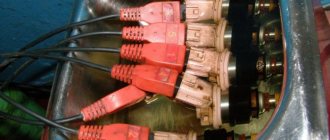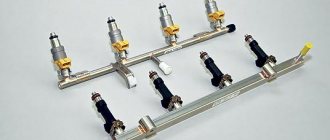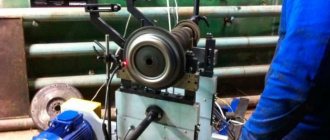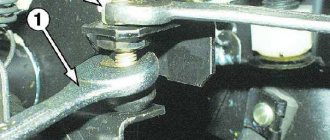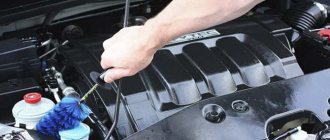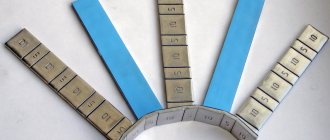A car may not operate correctly for a number of reasons - today we will talk about a dirty injector and nozzles, since this problem is extremely popular when identifying improper engine operation.
Most owners of cars with injection engines begin to worry if the car behaves suspiciously. The first alarm bells are the engine shaking strangely at idle. Popping noises are heard and the tachometer needle may jerk up and down randomly. Then you feel that when driving the car no longer accelerates so quickly, and the fuel from the tank seems to evaporate. Many continue to drive and put up with the unsatisfactory condition of the car. It’s worse when the engine shakes so much that vibrations go through the car body. Such a malfunction is difficult not to notice. But experienced motorists know that flushing the injector would quickly eliminate the problems and also bring the engine into a healthy state.
The cause of engine malfunctions is contamination of the fuel supply system. Dust, sand, and water that enter the tank are easily retained by the fuel filter. But after replacing it, the situation may not change. Then we can confidently diagnose contamination of the injectors and intake manifold.
Why is injector flushing required?
The factory purpose of fuel injectors is to properly spray the fuel mixture into the combustion compartment. More precisely, small drops are sprayed at an angle and in a certain shape.
If a nozzle becomes clogged, the quality of the spray decreases, namely, the configuration of the torch or the size of the droplets changes. In this situation, the fuel does not burn completely, traction decreases, and noticeable failures in engine operation occur.
Why does debris form in the injector when any vehicle has a fuel system kit with filter installed?
- This is not surprising, since the filter traps mechanical components. Iron oxides, rubber components and other substances also get into gasoline. Such impurities, under the influence of high temperatures in the engine, are attached to the plane in the form of a coating.
- This coating covers the sections of the nozzle, preventing it from spraying fuel productively. The rate of blockages in the fuel system largely depends on the quality of the fuel.
- If in big cities its characteristics are almost up to standard, then at numerous gas stations near the highway and in small settlements there are considerable problems with this.
The owner especially notices clogged injectors in winter. At this cold time, the fuel forms a viscous mixture, and therefore difficulties arise with starting the engine.
When to clean injectors
Cleaning of injectors on Lada cars is carried out according to the condition of the car. If there are no problems with your car, then there is no need to clean them. Also, to find out for sure whether the injectors need to be cleaned, you first need to diagnose the fuel system. You can learn more about how to diagnose the fuel system in our article.
The manufacturer recommends cleaning the injectors every 50,000 km. Since the fuel at our gas stations leaves much to be desired, just before this mileage they begin to become clogged and flushing them will be useful. You can wash it at a service station, or you can do it yourself. Next, we will look in detail at how to wash the injectors on a VAZ car at home.
Symptoms of a clogged injector
Here are the symptoms that the injectors are clogged:
- The engine starts poorly when cold, and after starting it is able to function unstably at transitional stages and idle rotations;
- As the speed increases, with the accelerator pedal fully depressed, dips appear;
- Significant increase in fuel costs when traveling;
- The engine power has weakened, the dynamic properties of the vehicle have decreased;
- Popping sounds are heard from the exhaust pipe;
- When the car is running, vibrations occur.
Improper spraying through dirty injectors increases fuel consumption, and if you delay cleaning, it can lead to their breakdown and the need to buy new parts.
Methods for cleaning the injector
The most sensitive part of the injector to dirt is the nozzles. Therefore, the words “rinse the injector” mean cleaning and washing the injectors.
There are 3 known methods for cleaning and washing these parts:
- Soft, not requiring removal of nozzles from the power unit;
- Manual type;
- Washing using ultrasound.
Before you start flushing the injector, you will need to determine the exact reasons for the malfunctioning engine. Sometimes it happens that difficulties do not come from dirty injectors, but due to incorrect operation of the meters or injection controller, as well as engine malfunctions.
We make a device
The injector cleaning device consists of two parts. The first will supply the cleaning agent. To do this, take the brake hose and cut off the metal threaded end on one side.
The nozzle will be attached to this end of the pipe, since the inner diameter of the hose is perfect for this.
At the other end, where the metal tip remains, we supply liquid.
To do this, take a plastic tube that comes with a can of cleaning agent (if you don’t have such a tube, you can take one from WD-40). We insert this tube into the metal tip.
To ensure a tight seal, you can cut a strip from a wine cork, roll it into a tube and insert it into the tip; it will act as a sealing spacer.
Then insert the tube from the can into this spacer; it should fit tightly. And then wrap it all tightly on top with electrical tape.
You should get a hose with a transition to a plastic tube for connecting a cylinder with cleaning liquid at one end, and a free second for connecting a nozzle.
At this point, the feeding part of the device is ready.
Let's move on to the electrical part.
To do this, you need two wires that will supply power to the nozzle during cleaning. Everything will be powered from the battery.
But in order not to apply increased voltage in the process and not to burn the coil winding of the element, it is necessary to embed an incandescent lamp into the wire that will supply the positive pole.
A toggle switch or button is embedded in the negative pole wire.
This is necessary for the convenience of work, so that you do not have to simultaneously supply the product to the nozzle and at the same time press the wires to the battery so that the nozzle works.
Softened washing method
A mild cleaning method consists of adding special additives to the fuel that dissolve sulfur and tar deposits. This is a very popular cleaning method among drivers.
- The advantage of the technique is that there is no need to remove the injectors from the engine; in addition, the gearbox valve is cleaned. After washing, it is worth changing the spark plugs.
- Experienced car owners combine both procedures, because by the time of the next injector cleaning procedure, the spark plugs should be changed.
- Considering that the injectors are not removed from their place, the quality of the cleaning procedure cannot be checked.
When the deposits have been washed off, the symptoms of a faulty engine will gradually disappear. This method has 2 disadvantages - it cannot be used when the car has traveled more than 10,000 km since the last tank flush.
Otherwise, there is a high risk of clogging the gasoline pump placed in the tank. But it cannot withstand serious pollution. Therefore, this method is recommended for prevention after traveling 4-6 thousand kilometers.
Application of gasoline additive
This procedure is best timed to coincide with replacing fuel filters and here’s why. The detergent additive is poured into the tank, so the cleaning effect extends to the entire fuel supply system.
Any foreign deposits that have been washed off rush into the filter meshes and quickly clog them. If you do not change the filter elements, you will not be able to properly clean the injectors, because dirt will reach them. So, to perform the operation you will need:
- liquid – fuel additive;
- fine and coarse mesh filters.
Before carrying out the procedure, it does not hurt to learn more about engine additives.
The method of use is simple: the chemical composition from the bottle needs to be poured into the tank and continue to operate the car. After 200-300 km, replace the filter elements. An important point: the amount of cleaner in the container is designed for a certain volume of gasoline; their ratio is always indicated on the product packaging. In order not to get a negative result and not to harm the engine, follow the prescribed dose of the composition.
Most often, car enthusiasts use injector flushing fluid from the following manufacturers:
- Hi-Gear;
- Kerry KR-315;
- Liqui Moly;
- Injector Cleaner concentrate from the American brand STP.
Do not use this cleaning method after a long mileage (over 15 thousand km), when a sufficient amount of deposits has accumulated in the system.
When washed, they will not only clog all the filters, but can also damage the fuel pressure regulator.
Cleaning the injector with ultrasound
In terms of effectiveness, this method of washing the injector is better than other methods. The method is based on the phenomenon of cavitation. This is when in a certain place the temperature of a liquid increases when combined with a solid surface under the influence of sound waves.
- For ultrasonic cleaning you need a special stand with a bathtub, an ultrasound generator and detergent are placed in it. Often craftsmen use a familiar dishwashing substance dissolved in water.
- Under the influence of ultrasonic waves, sharp heating plots appear on the plane of the nozzles inside and outside, which causes the appearance of steam bubbles. When the frequency and direction of the waves are chosen incorrectly, shells appear on top of the metal upon completion of cavitation.
- This will cause the device to break down. Therefore, you should not experiment with self-made ultrasonic baths and washing machines. Changing nozzles will be much more expensive than ultrasonic cleaning at a car service center.
To wash the injector in an ultrasonic bath, you need to reduce the pressure in the ramp, turn off the battery and remove it from the car. After washing, the parts are put back in place and connected.
Proper washing removes all contaminants from all parts of the injectors, including from the inside, thereby increasing engine power and reducing fuel consumption.
DIY ultrasonic bath
If the car owner has expressed a desire to clean the injectors independently, with his own hands, and has chosen ultrasound as the basis of the method, then he can use a household bathtub for this. For example, “Ultrasonic bath Ya Xun YX-2000A” with characteristics: 35-50W, 42KHZ, digital display, timer 1-240 s, volume 0.5 liters. In terms of power and volume, such a bath is quite suitable for carrying out a preventive procedure. For cyclic operation of the valve stem inside the nozzle, you can use an injector tester or the DST-6S device, which pulses open and close the valve.
Tester for checking actuators
But if there is neither one nor the other, then you can connect a constant voltage of 12 volts to the contacts. In this case, the fuel path of the injector will be constantly open during ultrasonic treatment. It is recommended to use LAVR Ultra-Sonic Cleaner liquid and heat it to 60 degrees to get positive results.
Manual method of washing the injector
In order to wash the injectors manually, you need to disconnect the battery and reduce the pressure in the fuel rail. An alternative method is also known:
- Start the engine and remove the fuel pump fuse. When the pressure drops, the engine will stall.
- Now you need to disconnect the battery, wipe the injector so that there is no dust or dirt on the surface.
- The fuel pipes from the injectors are removed (on some machines you will need to remove the entire ramp).
- The injector control wiring is disconnected. Here you need to avoid mixing up the wiring, otherwise the owner will not be able to start the engine.
- The injectors are unscrewed.
Before washing, you need to heavily spray the metal part of the part using a carburetor cleaner. It is possible to use different substances to clean the injector. This is required to separate resin layers.
Then the nozzles are laid to lie down for 3-5 minutes, during this period the product should have an effect.
Using cleaning fluid
The best way to wash the injectors without removing them from the engine ramp is to connect a container with a flushing solution directly to the fuel line of the power unit. The procedure will not affect other elements of the system - filters, pump and pressure regulator. But you will need to make a simple device from the following parts:
- car gasoline hose 1 m long;
- cheap fuel filter with a paper element;
- hose clamps;
- 2 valves for tubeless tires, equipped with spool valves;
- 2 liter plastic bottle;
- manual or electric pump with pressure gauge.
It is necessary to make holes in the bottom and cap of the bottle, selecting the diameter of the drill to match the size of the valves. Then, you need to insert a valve without a spool into the hole made in the plug and attach the hose to it with a clamp. Afterwards, the hose is cut in half and a fuel filter is placed in the gap, observing the direction of flow (from the bottle). A valve with a spool is inserted into the second hole, where the pump is connected. For convenience, it is advisable to hang the bottle from the open hood with the neck down. The device is ready.
Before washing the injector directly on the car, you need to connect the homemade system to the fuel rail, for which you will have to relieve the pressure in it. Find the process fitting with a spool built into the end of the ramp, place a plastic cup under it and press the valve with a sharp object. Excess fuel will pour into the glass and the pressure will drop. Then follow this algorithm:
- Disconnect the main fuel line from the rail and connect the hose from the bottle in its place.
- Disable the car fuel pump by removing the corresponding fuse. Another option is to place a gasoline can under the disconnected line.
- Pour all the wash liquid from the bottle into the bottle.
- Connect the pump and pump the container into a pressure of 3 Bar (no more!).
- Start the engine at idle speed. Now it runs not on gasoline, but on washing liquid.
- Flushing continues until the motor has used all the fluid. During operation, you need to monitor the pressure in the plastic bottle and maintain it with a pump at 2.7-3 Bar.
The cleaning procedure is performed on a warm engine, so it must be brought to operating temperature before connecting the flushing device.
Using the technology described, cleaning the injector yourself is quite simple, and it won’t take much time. It is advisable to combine the procedure with changing the engine oil, since when flushing, some of the liquid that is not burned in the cylinders may get into the crankcase. The mileage between engine lubricant changes approximately corresponds to the frequency of preventive cleaning of injectors.
Materials
To clean it manually, you should stock up on:
- Three wires with a length of 50 -100 cm;
- The energy source is 9 -12 V. If you use a car battery, you need to install a resistor in series with it for resistances of 50-200 Ohms;
- Push-button switch;
- 1-2 small bottles of cleaning fluid for the carburetor;
- Plastic and rubber tubes for connecting the can with the nozzle. Some specialists in this matter use a syringe with a capacity of 5 ml, put its extension on the nozzle, and install a purifier tube in the second part.
One end of the conductor is connected to an energy source or battery and an injector. The other is connected to the battery and the button. The third is connected to the button with the nozzle. It is recommended to use standardized terminals.
A tube or syringe is placed on the nozzle, and a can is connected. It is best to wash with two people.
Cleaning with carb cleaner
Cleaning injectors with carburetor cleaner Carb Cleaner is not widely used and this is justified by the following reasons:
- Firstly, the procedure requires special care and strict adherence to eye protection measures.
- Secondly, cleaning is performed with minimal pressure coming from the carb cleaner cylinder.
- Thirdly, it is necessary to remove the nozzle from the ramp.
Despite the listed disadvantages, flushing the carburetor with cleaner is a convenient and effective remedy in force majeure circumstances, when the car is on the road and a fuel system malfunction occurs far from a car service center.
Technologically, the procedure is not difficult to perform and it is enough to have on hand a bottle of carburetor cleaner and two pieces of wire with a minimum length of 1 meter. Wires connect the injector contacts to the 12 V battery. When voltage is applied to the injector, the valve opens and in any available way it is necessary to inject liquid from the carburetor cleaner bottle into the inlet tract, and do not forget to protect your eyes with goggles.
There is a large selection of carburetor cleaners on sale, and which one is best to choose for cleaning injectors is difficult for the car owner. It is better to choose one that effectively dissolves hardened resin fractions.
Practice in preventive cleaning of injectors shows that the most effective means, besides Carb Cleaner, are:
- Hi-Gear carburetor cleaner: a popular product that easily and effectively removes various carbon deposits and deposits.
- Carburetor cleaner "Lavr".
- Abro carburetor cleaner: is a good tool for cleaning fuel system elements and throttle assembly.
Purification process
You need to press and hold the spray can. Then he presses the button that serves as a switch - once every 5 seconds with a press delay of 0.3 seconds.
- There should be 5 presses in total. The nozzle is removed and put aside, waiting until washing dissolves the internal blockages.
- The remaining injectors are also washed in this way. The washing procedures are completed when all parts are sprayed equally.
This happens in 3-4 cycles of repetitions. You also need to blow out the nozzles with compressed air by pressing the button; if necessary, the sealing rubber bands are replaced and installed on the machine.
